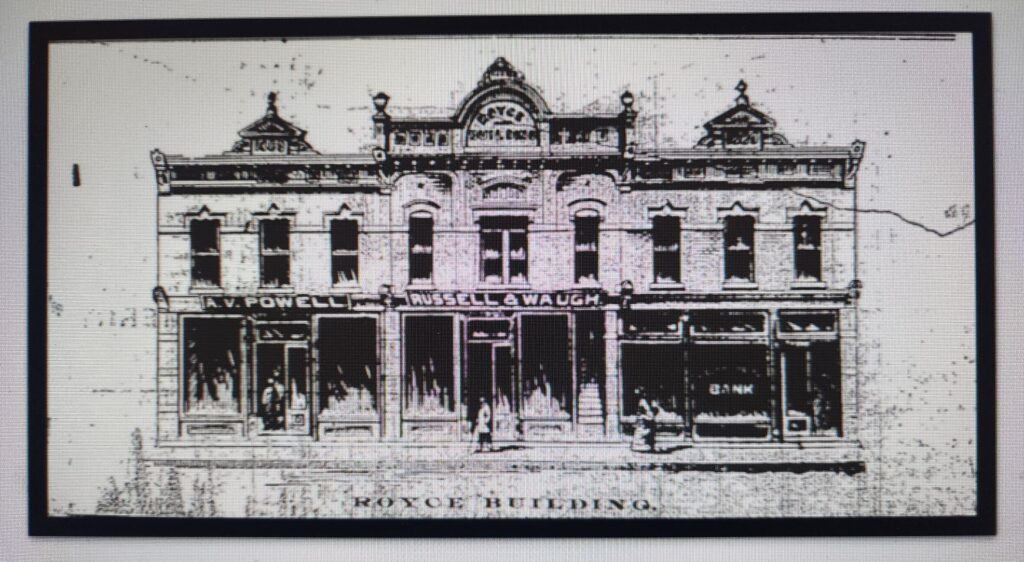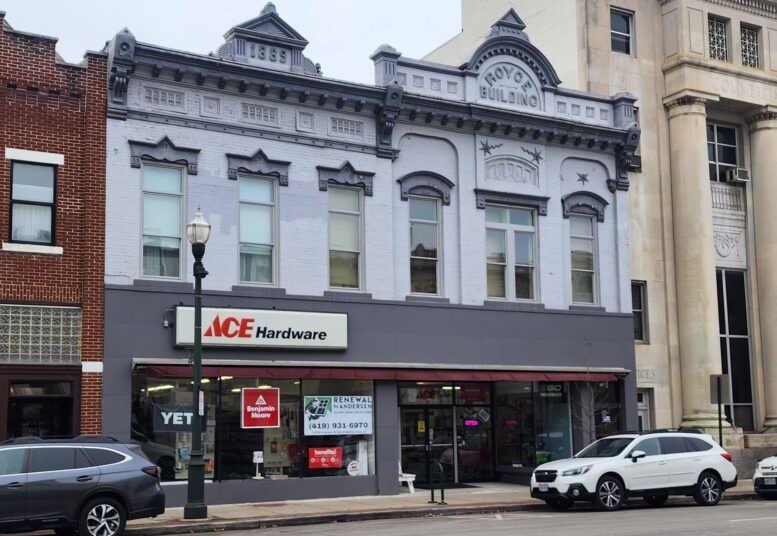Written by Geoff Howes, Bowling Green Historic Preservation Commission
As its Historic Building of the Month for February, the Bowling Green Historic Preservation Commission has selected the Royce Building at 136 S. Main St., currently home to the Ace Hardware store. This elegant Italianate building is part of the Main Street Historic District, which was placed in the National Register of Historic Places in 1980. It is also featured on the HPC’s interpretive historical sign “Commerce and Finance in Old Bowling Green” across the street from the 136-year-old structure.
In August 1889, the Wood County Sentinel & Gazette reported: “Work on the new Royce Block proceeds with satisfactory rapidity, considering the extreme difficulty experienced in procuring masons and other mechanics.” The boom that had started when oil was discovered in Wood County in 1884 was well under way, and there were not enough workers to keep up.
By September, however, the building was open, with the Commercial Bank on the first floor of the north wing and J. A. Walker’s photography studio on the second floor. In November, the new grocery firm of Russell & Waugh moved into the center section, and A. V. Powell’s novelty store announced that in December it would open in the “elegant and commodious south room of the new Royce Building.”
Powell’s advertised “a new and fine line of VARIETY GOODS, consisting of 5 & 10-c Goods, Notions, Toys, Children’s Vehicles, Dolls, And 400 different articles besides!”

In December 1889 the Wood County Tribune celebrated Bowling Green’s growth with a series of engravings of downtown buildings, including the Royce Building, of which the Tribune wrote: “This handsome block stands as a monument of enterprise to the man whose name it bears.”
That man was Albert E. Royce (1844-1914), a leading businessman in Bowling Green, who was successful in agriculture and the grocery business and became a property owner and banker as president of the grain processing firm of Royce, Smith & Coon, which established the Commercial Banking Company. At various times he was also a member of City Council and a director and treasurer of the Board of Trade. He owned the second oil well drilled in Wood County as well as grain elevators and grist mills in several nearby towns.
Royce married Elizabeth Curson in 1867. They had one child, Maud, who married the prominent merchant F. E. Whitker. Elizabeth died in 1877, and in 1888, Royce married Hattie Cargo. Their daughter Bess tragically drowned in 1911, at age 16, in a boating accident on the Maumee River.
When A. E. Royce died on Nov. 1, 1914, the Wood County Sentinel Tribune reported: “At the time of his death, Mr. Royce was president of the Commercial Bank here, vice-president of the First National Bank at Weston, treasurer of The Bowling Green Monarch Underwear Co. of Bowling Green and president of the Wood County Fair company which he had helped to found.” He was a member of the Presbyterian Church and the Masonic Lodge.
Until her death in 1939, Hattie continued to live in the Royce residence, which still stands at 333 W. Wooster St., in the Boom Town Historic District. It was later the home of G. Kenneth Urschel, son and successor of B. H. Urschel, one of the founders of the Urschel Engineering Company that once stood on Troup Avenue. The Royce family plot can be found in Oak Grove Cemetery, and on Find-a-Grave: https://www.findagrave.com/memorial/111207461/albert-e-royce.
Later businesses located in the Royce Building include Frank M. Long Dry Goods, Stratton & Powell hardware, J. F. Long & Rutherford hardware, Joseph & Pope Dry Goods, and Coen Grocery. Among the professionals who had offices in the block were the attorney Abel Comstock, the law firm of Troup & Dunn, the attorney S. Saltonstall, the physicians R. N. Whitehead and W. L. Mathers, and C. B. Eberly, an insurance and real estate agent.
In 1926, the bank that A. E. Royce had helped establish built a new neoclassical structure, the Commercial Bank & Savings building, at 130 S. Main St. The north wing of the Royce Building, which had housed the bank since 1889, was demolished, sacrificing the symmetry of the original building to make way for this imposing three-story limestone building. (The Commercial Bank building, later the Bank of Wood County and Huntington Bank, was the Historic Building of the Month for August 2024.)
Also in 1926, the J. C. Penney company established a store on the ground floor of the center and south sections of the Royce Building, where it was to remain until 1987, when it moved to become an anchor of the new Woodland Mall on North Main Street. In that same year, Floyd Craft, the owner of the Ben Franklin store on South Main, opened a True Value hardware store in the Royce block. Craft’s store became an Ace Hardware franchise in 1996.
In 2023, Dave and Kati Thompson purchased the Ace Hardware store from Floyd Craft. As the BG Independent News of Jan. 13, 2023, reports, Dave Thompson brought a strong interest in old buildings to his new acquisition. A veteran of the construction business, he had worked on old houses that other contractors didn’t want to deal with. “’I fell in love with the architecture of these old places.’ And as he’s discovered the hardware store has plenty of quirks. ‘These buildings were not built square.’” While the ground floor façade is now a modern glass storefront, the ornate architectural details on the second floor can still be admired just as they were in 1889.
Would you like to nominate a historic building or site for recognition? You can do this through the city website at – https://www.bgohio.org/FormCenter/Planning-13/Historic-BuildingSite-Nomination-Form-83
You can learn more about the Historic Preservation Commission by attending the meetings, on the fourth Tuesday of each month at 4 p.m., or by visiting the webpage at – https://www.bgohio.org/436/Historic-Preservation-Commission.

